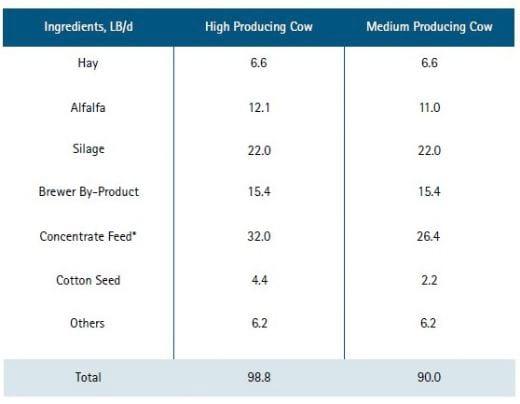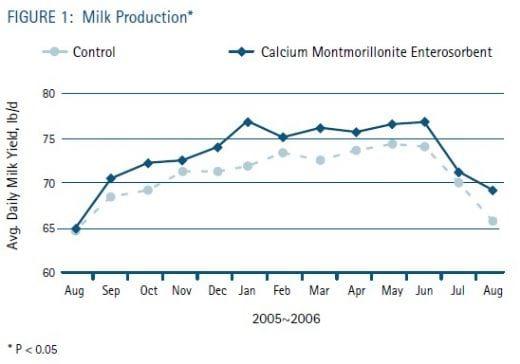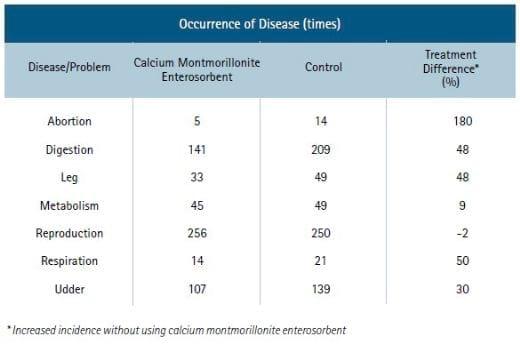Enterosorbents in Dairy Cows
The Benefits of Enterosorbents in Dairy Cows
Published: March 31, 2011
By: Fang Chi, Ph.D., Technical Services Director
The dairy cow's immune system and clinical health respond to constantly changing stresses and disease challenges. The stresses and disease challenges include parturition, weather, disease, farm management, quality of feeds, feed ingredients and forage, etc. When the stress and disease challenge level is above the threshold that a cow can handle, clinical symptoms will occur. However, if stress and disease management technologies are employed on a daily basis, it will reduce the stress and disease challenge below the cow's tolerance threshold, therefore clinical signs will not occur and the performance of the cow will improve.
Based on the hypothesis above, we conducted a 12 month feeding trial (between 2005 and 2006) involving over two hundred and eighty lactating cows. The cows were fed commercial feeds with or without 0.3% addition of calcium montmorillonite enterosorbent in concentrated feeds.
The Feeding Trial
A total of 280 Holstein cows were used in the study initially. Cows were continuously added to or removed from the study based on standard farm practices. The 280 lactating cows were divided into two groups (4 houses with 70 cows per house) according to their age and milk yield. All cows were fed one of the two diets, based on their milk production, and evenly distributed into the two groups, addition of either 0% or 0.3% of calcium montmorillonite enterosorbent in concentrate feed. Cows were fed three times a day (6:00, 13:00, and 20:00) and milked three times a day (7:00, 14:30, and 20:45). The compositions of rations are shown in the Table 1.
Based on the hypothesis above, we conducted a 12 month feeding trial (between 2005 and 2006) involving over two hundred and eighty lactating cows. The cows were fed commercial feeds with or without 0.3% addition of calcium montmorillonite enterosorbent in concentrated feeds.
The Feeding Trial
A total of 280 Holstein cows were used in the study initially. Cows were continuously added to or removed from the study based on standard farm practices. The 280 lactating cows were divided into two groups (4 houses with 70 cows per house) according to their age and milk yield. All cows were fed one of the two diets, based on their milk production, and evenly distributed into the two groups, addition of either 0% or 0.3% of calcium montmorillonite enterosorbent in concentrate feed. Cows were fed three times a day (6:00, 13:00, and 20:00) and milked three times a day (7:00, 14:30, and 20:45). The compositions of rations are shown in the Table 1.
TABLE 1: Ration Compositions


* Compositions of concentrate feeds were different between high and medium producing cows and calcium montorillonite enterosorbent was added into concentrate feed at levels of either 0% or 0.3%.
Feeding Enterosorbents Significantly Increased Milk Yield
Milk production over the 12 months feeding period is shown in the Figure 1. Milk production between the two groups were similar at study initiation; however, cows that son received the ration containing calcium montmorillonite enterosorbent showed increased milk production after one month of feeding. Cows fed the ration containing calcium montmorillonite enterosorbent had an average daily milk production of 73.04 lb over the study period, while cows fed the control diet produced an average daily milk yield of 70.63 lb during the same feeding period. The difference in average daily milk yield was statistically significant (P = 0.04).
In both groups, milk production was increased after August 2005 and remained high over the winter and spring months, and then decreased in July 2006. The change was mainly due to environmental temperature and not because of different lactation stages. Feed consumptions between high and medium producing cows were different (Table 1). However, feed consumption between cows fed rations with or without the addition of calcium montmorillonite enterosorbent were not different.
This indicated that the increased milk production was not due to changes of feed intake. Therefore, the efficiency of converting feed to milk was significantly improved by adding calcium montmorillonite enterosorbent in the ration.

Feeding Enterosorbents Did Not Alter Milk Compositions
No differences in average milk fat and milk protein were observed between two treatments (Table 2).
TABLE 2: Average milk fat and milk protein with or without the addition of calcium montmorillonite enterosorbent in rations.

Feeding Enterosorbents Improved Dairy Cow Health
Table 3 lists disease incidence, by cause, over the 12 month feeding period. Cows that did not receive rations containing calcium montmorillonite enterosorbent showed a 180% increase in abortions and a significant increase (30-50%) in digestion, leg, respiration, and udder problems within the 12 month period. No differences were found with metabolism and reproduction problems between the two treatments.
TABLE 3: Disease occurrence within the 12 month feeding period, with or without the addition of calcium montmorillonite enterosorbent in the ration.
Feeding Enterosorbents Significantly Increased Milk Yield
Milk production over the 12 months feeding period is shown in the Figure 1. Milk production between the two groups were similar at study initiation; however, cows that son received the ration containing calcium montmorillonite enterosorbent showed increased milk production after one month of feeding. Cows fed the ration containing calcium montmorillonite enterosorbent had an average daily milk production of 73.04 lb over the study period, while cows fed the control diet produced an average daily milk yield of 70.63 lb during the same feeding period. The difference in average daily milk yield was statistically significant (P = 0.04).
In both groups, milk production was increased after August 2005 and remained high over the winter and spring months, and then decreased in July 2006. The change was mainly due to environmental temperature and not because of different lactation stages. Feed consumptions between high and medium producing cows were different (Table 1). However, feed consumption between cows fed rations with or without the addition of calcium montmorillonite enterosorbent were not different.
This indicated that the increased milk production was not due to changes of feed intake. Therefore, the efficiency of converting feed to milk was significantly improved by adding calcium montmorillonite enterosorbent in the ration.

Feeding Enterosorbents Did Not Alter Milk Compositions
No differences in average milk fat and milk protein were observed between two treatments (Table 2).
TABLE 2: Average milk fat and milk protein with or without the addition of calcium montmorillonite enterosorbent in rations.

Feeding Enterosorbents Improved Dairy Cow Health
Table 3 lists disease incidence, by cause, over the 12 month feeding period. Cows that did not receive rations containing calcium montmorillonite enterosorbent showed a 180% increase in abortions and a significant increase (30-50%) in digestion, leg, respiration, and udder problems within the 12 month period. No differences were found with metabolism and reproduction problems between the two treatments.
TABLE 3: Disease occurrence within the 12 month feeding period, with or without the addition of calcium montmorillonite enterosorbent in the ration.

Conclusions
The study proved that calcium montmorillonite enterosorbent used on a daily basis provided significant benefits to the dairy operation. Use of 2 to 4 ounces per cow per day improved general health and milk production. Cows fed the ration containing calcium montmorillonite enterosorbent for 12 months showed benefits:
• Greater milk production (P < 0.05)
• Lower milk somatic cell counts (P < 0.07)
• Fewer health problems such as abortions, leg, digestion, respiration, and udder problems
• Lower milk somatic cell counts (P < 0.07)
• Fewer health problems such as abortions, leg, digestion, respiration, and udder problems
Related topics:
Authors:
Amlan
Recommend
Comment
Share
Amlan
13 de abril de 2011
Dear All,
Thank you very much for your comments. We have two inquires regarding the mechanism of enterosorbent. My suggestion is go to 'www.amlan.com'. In the web site, you can find animation clips using poultry and swine as model to discuss the enterosorption therapy of mycotoxins. I believe you will find it useful.
Dear Dr. Daoud, please let me know your e-mail address and I will send a pdf file to you. My e-mail is fang.chi@oildri.com
Thank you very much.
Recommend
Reply

20 de noviembre de 2011
i want to know more about animal nutrient also I will need more information about the mechanism of product
Recommend
Reply
Recommend
Reply
Recommend
Reply
13 de abril de 2011
Successful and profitable Livestock production depends on strong immunity of farm animals which will keep animals ready to fight against such diseases which cost livestock producer much thus bringing down the profitability of the farm. This is a good article and I will love to have more information about the mechanism of this product
Recommend
Reply
13 de abril de 2011
Dear Dr. Chi,
It is a fantastic information in terms of dairy cattle management.But I am interested to know actually how enterosorbents work inside the body? You sure must have some more informations please if you can share it.
Thank you.
Recommend
Reply

13 de abril de 2011
Dear Sir,
I have about 120 local Omani cows (low milk producer)
I want to improve milk production by using your technique. If you have any recommendation please tell me.
Recommend
Reply
13 de abril de 2011
Dear Fang Chi
Its a decent information on dairy cattle performance. Can you you please elaborate precise mechanism of action of enterosorbent used in this study because you mentioned that it did not affect feed intake. Thanks
Recommend
Reply
12 de abril de 2011
This is a new way on dairy cow nutrition and i want to know if you can send me the full article
Recommend
Reply

Would you like to discuss another topic? Create a new post to engage with experts in the community.




.jpg&w=3840&q=75)




.jpg&w=3840&q=75)